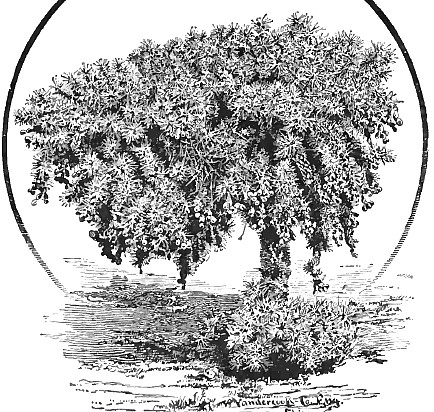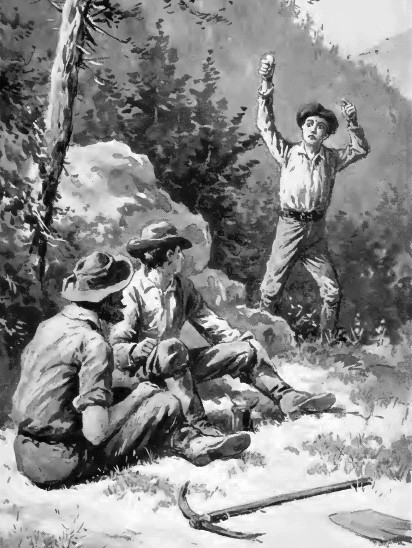One of the best known of what have been called the desert mines of Arizona was the Harqua Hala in Northeastern Yuma County, a bonanza of relatively late date. It brought its original owner $75,000, and later was sold to an English corporation by Hubbard & Bowers for $1,350,000. Three times it had been reported worked out, but two of these times almost accidental prospecting uncovered great lenses of ore running high in native gold. Within the plains of southern and central Yuma County have been found many rich gold mines, from the cement placer deposit near Quartzsite down to almost the Mexican line. Some of these, such as the King of Arizona and the North Star, produced phenomenally for a while, but failed to retain value with depth. One of the richest and most enduring of these, desert gold mines was the Fortuna, from which millions of dollars were taken up to early in 1903, when the shaft was destroyed by a slip that caved in the lower levels.
In the northern part of Yuma County large expenditures were made about 1910 by the Clara Consolidated Copper Company, a corporation mainly capitalized in Los Angeles, which built a smelter and railroad before it had developed its ore body. The usual result followed and the smelter has been idle save for a few months, and the company has passed through bankruptcy. One of the best known of the pioneer mines was the Gunsight, in Myers district, twenty miles north of the Mexican border, in south-central Pima County, discovered in November, 1878. Early shipments of ore were made with returns net at the rate of $1,200 a ton. The name itself was significant of riches, for from the croppings one of the discoverers whittled himself a pure silver gunsight, to replace one that had been lost. The ore was heavy in lead.
A forty-two mile railroad has just been completed to connect Gila Bend with the old Ajo camp, Arizona's first copper producer. The mines now are held by a company subsidiary to the Calumet and Arizona, and more than $5,000,000 has been spent in preparations for working the great deposits that are said to average not over 2 per cent in copper. Yet, through the perfection of modern mining processes, even this small saving of forty pounds of metal to a ton of ore is expected to bring in large profits.
At Ajo has been developed a reduction process believed to be worth many millions to Arizona copper miners. Success has attended experiments in treating the surface azurite and malachite carbonate copper ores, which heretofore have been considered beyond economical reduction when carrying less than 5 per cent copper. Now it has been demonstrated possible to concentrate carbonates which were thought before only suitable for smelting. In February, 1908, at Sasco (Southern Arizona Smelting Company) was started the smelter of the Imperial Copper Company, a company subsidiary to the Development Company of America. The ore came from the well-known pioneer Old Boot mine at Silver Bell. The furnaces were closed down in 1910, owing to the inability of the company to find profit in the handling of the copper ore which seems to have been too low grade for reduction by smelting process. Immediately two fair-sized towns were deserted.
THE FAMOUS SILVER KING
One of the greatest silver mines in the world, undoubtedly the greatest mine
of its class within Arizona, was the Silver King, located at the camp of the
same name, beneath the western buttresses of the Pinal range, in the
northern part of Pinal County To this day, small miners or "chloriders" are
still finding valuable ores in extensions of the outer workings, at no great
depth from the surface. Still the old mine itself, with its chimney-like ore
formation, was worked to a depth of 1,000 feet, yet it is more than half
filled with water and is dangerous at any point. In the days of its activity
it disbursed about $1,500,000 in dividends, and was one of the few Arizona
stocks regularly quoted on the San Francisco Stock Exchange. Its mill was
located at Pinal, five miles from the mine, a camp better known to old
timers as "Picket Post," for the most prominent feature of its landscape was
Picket Post Butte, one of the signal stations of the Apaches, from which
they could sight the passing of enemies for many miles around. To this camp,
in 1876, came Harry Brook, a professional newspaper man, who, for awhile,
tried to find fortune in the editing there of a weekly newspaper, The Pinal
Drill; but "The Drill" left pay-rock behind long ago, and the towns of Pinal
and Silver King are mere heaps of crumbling adobes. Probably the best
historian of the Silver King is Brook himself and the liberty, therefore, is
taken of quoting from his writings on the subject.
Great chunks of absolutely pure virgin silver were dug out of the Silver King. The superintendent, Aaron Mason, would sometimes drive down from the mine to the mill with a string of wire silver several feet long twisted around his sombrero. They sent native silver to the mint and had it made into silver dollars, which were given away as souvenirs. We have heard much, of late, in regard to "high grading"—in plain English, stealing—of rich gold ore in Nevada. Well, at the Silver King the stealing of silver ore was a common thing, and several "fences" were prosecuted and sent to jail. Men on the big ore teams would throw off chunks of rich ore, which were picked up by confederates. It was said that the dust of the five-mile stretch between the mine and the mill would average at least $5 a ton in silver.
At this time that the Americans had come to aid them in driving out the Mexicans, but Doniphan and his Missourians stayed for a while until he showed the wild Indians the error of their ways. December 14 he started for Mexico, leaving in command at Santa Fe Col. Sterling Price, later celebrated in the armies of the Confederacy. Near the present Los Cruces, Doniphan made a good beginning by defeating an attacking Mexican force. Soon thereafter a general uprising was planned by the deposed Mexican officers, supported by Padres Ortiz and Gallegos. It was planned that there should be a general rising December 19. A delay till Christmas Day afforded time for the information of the Americans, who promptly arrested the leaders.
The following month the insurrection broke out unexpectedly and on January 19 a body of Mexicans and Indians at Taos killed Governor Bent, Prefect Vigil, District Attorney Leal, Narciso Baubien and Pablo Jaramillo, the last named the Governor's brother-in-law. Americans also were killed at a number of other places. Colonel Price had only a small force, in all amounting to 310 men. Some of these were local Americans who had rushed to the colors and a number of prominent New Mexicans. The American commander did not wait for the arrival of a hostile force that was marching down the Rio Grande, but offered battle in the field. There were two engagements near Santa Cruz and Embudo and one at Taos, to which the New Mexicans, inferior to the Americans in everything but numbers, had been driven. The rebellion finally was wiped out by an engagement at Fernandez de Taos, in which the Americans at short range battered down the walls of the church that had been transformed by their foe's into a fortress. The battle was a sanguinary one. Captain Burgwin and about a score of Americans fell, but at least 150 of the insurgents were killed. Their leader, Montoya, and fourteen others were executed, after trial for the murder of Governor Bent and his associates. Others sentenced to death for treason were pardoned by the President of the United States on the ground that no treason could be shown while Mexico was at war with the United States.
Return
to The Arizona Page:
Arizona Gold Rush Mining History



